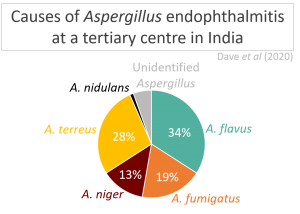Submitted by Aspergillus Administrator on 20 November 2012
The news channels in the UK have recently carried several stories on the newly identified fungal disease of Ash trees caused by the fungus Chalara Fraxinea. The main thrust of the stories is that this heralds the arrival of a new fungal disease in the UK which will cause the demise of one of our most common trees in a similar way to that seen 30-40 years ago when Dutch Elm Disease reduced another of our native tree species from a huge tree that dominated our landscape to what is now generally growing as a small hedgerow bush. Incidentally this nicely illustrates the power of a fungus to change our landscape even today as Dutch Elm Disease is caused by the fungus Ophiostoma ulmi.
Dutch Elm Disease was naturally spread by an insect that was probably imported into the UK on a load of imported timber whereas the new Ash fungal pathogen seems to have arrived in the UK via a wind dispersal mechanism as infected imported stock had been destroyed, but this conclusion remains in some doubt as prior to being detected in the UK the fungus is not known to have travelled more than 20km via wind – and the UK is more than 20km distant from the continent!
Why do we suddenly get such hugely destructive invasions of plant pathogens? Again the story of Dutch Elm disease provides useful information. The fungus that causes Dutch Elm Disease is known to have been in the UK for many years prior to the death of all of our Elms. Our native strain of Ophiostoma ulmi was however quite a mild pathogen and seemed mainly responsible for killing a few branches of an infected tree rather than killing the whole tree. It was the arrival of the highly virulent strain from North America that caused destruction on a large scale, and that arrival was caused by human intervation in the form of the international trade in timber.
Likewise Ash dieback has been caused by the arrival of a highly virulent strain of Chalara Fraxinea against which our native Ash trees have few defences. The isolation of our island has probably protected our native trees up until now but it is as yet unclear if human intervention was again the cause of the spread or if some unknown natural dispersal mechanism bridged the English Channel. Nonetheless this is an unusual situation and it will rapidly resolve as trees (the host) and pathogen (the fungus) interact over the next few years – most probably leading to the demise of most of our Ash trees.
Pathogen and host usually exist side by side in a relatively benign ‘war of attrition’. The fungus will have limited ability to attack the host and will not usually be able to kill it – otherwise the pathogen would quickly run out of hosts and die out itself! Each will slowly attack and defend from the other. It is only when neither has come into contact with the other that we get these spectacular die-off events and we regularly find that human activities are the cause.
What will happen to our Elm & Ash trees now? More than likely resistant strains of the host will grow out eventually and in time may repopulate the countryside, though there is a possibility that will not happen for many years. This is a completely natural process and once set in motion there is not much that we can do to stop it. Sadly Constables landscapes will not be the same again for many years.
News archives
-
Title
Date




